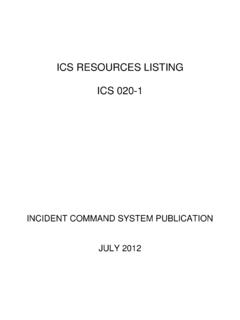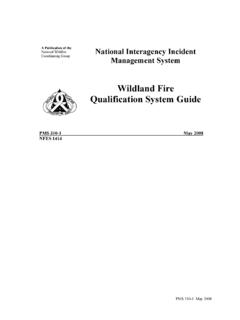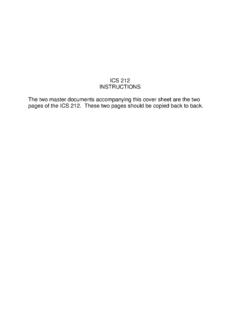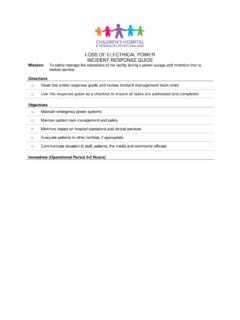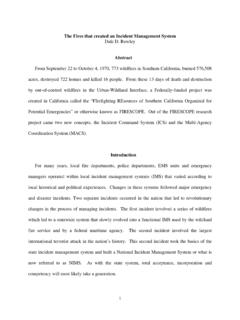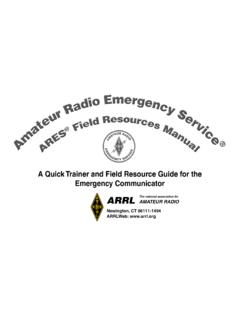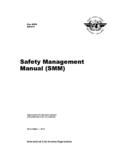Transcription of Emergency Response to Tactical Law Enforcement …
1 Emergency Response to Tactical Law Enforcement Incidents Tactical law Enforcement incidents present unique challenges to responders that may include: an active shooter, a barricaded suspect, a hostage situation, a high-risk (known felon) warrant service, and possible terrorist acts. Tactical law Enforcement incidents have the potential to result in serious injury to law Enforcement officers, fire department personnel, EMS responders, the public, and/or the suspect(s). Depending on the tactics employed and the actions of the suspect(s), these incidents can become more complex due to resulting explosions and/or fires.
2 These incidents require unique planning and Standard Operating Guidelines (SOG). Tactical law Enforcement incidents require close coordination between law Enforcement , fire, and EMS responders due to the threat complexity. Whenever possible the fire service should consider force protection when working in this environment. These incidents often involve the identification of zones (Hot, Warm and Cold) that indicate the level of threat in a given location. The concept of cover and concealment will be seen throughout the document and is explained in detail in the definitions.
3 It must be understood that even though you are utilizing cover or concealment, you are not guaranteed to be safe. A cold zone can normally be considered a safe location, however these incidents are dynamic and continuous evaluation should take place. PRE-PLANNING CONSIDERATIONS. Develop Standard Operating Guidelines/Policies, model IAP's, assess Risk versus Gain, determine adequate personal protective equipment (PPE) and determine leader's intent. Develop communication interoperability with EMS, law Enforcement , or any other cooperating agencies.
4 Identify different work zones within an incident . Identify Target Hazards and key components to each; control rooms, master keys, card swipes, isolation corridors, maps, and internal communication systems if applicable. Assess soft targets identified by law Enforcement such as bus/train stations, hotels, hospitals, theaters, concerts, shopping malls, schools and airports. Train personnel on operational tactics, strategy, and contingency considerations similar to a Rapid Intervention Crew ( ). Develop joint training with assisting/cooperating agencies.
5 INITIAL DISPATCH CONSIDERATIONS. Confirm type of incident active shooter, barricaded suspect, hostage situation, terrorist acts. Verify scene security. Determine the number of victim(s)/hostage(s), and their status. Don appropriate personal protective equipment (PPE), including helmets and protective body armor. Identify hazards, threats, and/or intelligence. Page 1. Emergency Response to Tactical Law Enforcement Incidents Identify incident Command Post (ICP) location and Staging Areas, control points, or any established perimeter.
6 Determine appropriate access and Response routes. Identify communications plan. Determine protective actions status and needs. Identify law Enforcement contact person or Liaison with phone number. Determine overhead and resource needs. Determine the resource ordering process. INITIAL BRIEFING. Obtain briefing from law Enforcement upon arrival and develop the ICS organization as necessary. Establish Unified Command (Reference FOG manual 420-1, Chapter 6-Unified Command). Establish and communicate Leader's Intent.
7 Determine level of Force Protection required to take action. Ensure Force Protection is assigned to groups or functions as needed. Coordinate with local law Enforcement to confirm type and location of threat. Obtain current incident status and threat assessment. Determine resources currently assigned, requested, and their locations. Determine the number of suspects/threat and their status. Determine the number of victim(s)/hostage(s), status. Identify incident potential. Identify zones and perimeters. o Do not get fixed in on concentric circles surrounding a crisis site, the zones might be discontinuous depending on shooter or threat locations and available cover or concealment.
8 Identify incident Objectives. Determine if shelter in place or evacuation strategy is going to be implemented? Determine number and location of sorting areas for evacuees to facilitate law Enforcement processing. Confirm incident Communications Plan. Determine type of frequencies; low band/high band, encrypted/non-encrypted, narrowband/wideband. Establish and communicate appropriate Escape Route(s). MEDICAL RESOURCE MANAGEMENT. Determine appropriate location for staging of medical resources. Identify patient treatment area.
9 The Staging Area should: o Provide rapid access to the incident location. Page 2. Emergency Response to Tactical Law Enforcement Incidents o Be located outside the view of the incident location. o For operational efficiency, separate staging areas may be identified for each discipline. o Consider requesting law Enforcement for security. Verify ambulance transport capability. Order additional units as needed. Notify the appropriate medical authority. Determine status of local medical facilities, drawdown or diversion.
10 Provide rapid egress of patients to pre-designated extraction points. Identify and secure Landing Zones (LZ's) in coordination with Law Enforcement . Develop ambulance loading ingress/egress traffic plan. Tactical MEDICAL TEAMS. WEAR appropriate level of Tactical PPE ( body armor). If Tactical Medical Teams are present, obtain briefing and determine their possible resource needs. Depending on complexity, multiple medical teams may need to be deployed around incident . All Emergency medical care performed by Tactical Medical Team members will conform with local Patient Management Protocols and guidelines as scene safety allows.

